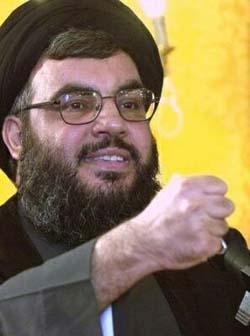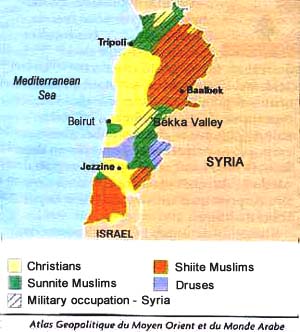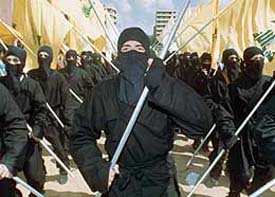AREN’T YOU MISSING SOMETHING ABOUT LEBANON? –
For the last three weeks the media has been teeming with news reports on the recent development of the 40-year-war between the Jews and Arabs in the Holy Land. Two Israeli soldiers were kidnapped by Hezbollah commandos, and the Jews destroyed some of their bases of operations in the Lebanon territory. Hezbollah retaliated by launching missiles that are damaging not only Jewish military targets, but also civil and religious ones. Israel, in turn, hit back and is broadly bombing targets that are or could be used for launching missiles. These actions also include strong collateral harm to civilians.
 08-08-06.jpg)
The loss of civilian lives increases indignation on both sides |
No one wants civilian populations to be harmed in war efforts. In most cases it goes against Natural Law and Catholic Morals, as well as violates the International Law admitted in civilized nations. So, since both sides are wounding and killing civilians, this adds a great deal of indignation to the picture. In the need to vent this indignation, the leftists furiously blame Israel, and the rightists heatedly blame Muslim terrorism. In this setting of cross-accusations, it is difficult to find a full, serene analysis of the situation.
Regarding religion, I am against the Jews and Muslims. Regarding politics, I think that the only solution for the Holy Land is to be a Catholic Kingdom, as established and held by the Crusaders for 200 years. Today there is no means to re-apply or update that model. So, I keep watching to see the action of Divine Providence regarding the Land where Our Lord Jesus Christ walked and sanctified by contact with His Divine Feet. Therefore, even though I am sorry for the futile loss of human lives and for Catholics who are suffering in Lebanon, I find no reason to become emotional about this conflict between Hezbollah and Israel. With this presupposition, let me try to see through the foggy panorama.
Lebanon: A no man’s land
In this conflict the first thing to strike me is that the Lebanese government is almost absent in the picture. The decisive man in Lebanon is Sheik Hassan Nasrallah rather than First Minister Fuad Siniora. It is Nasrallah who threatens Israel and dictates what will happen next. And what he says does happen. He acts as the chief, and doesn’t care about Siniora or anyone else in the government.

Hassan Nasrallah, the only effective leader in Lebanon |
In his turn, Siniora weeps, makes public appeals for a cease-fire, and proposes a seven-point-plan that follows the agenda of Hezbollah. The facts show that both terrorists and Israelis are free to come and go in Lebanon at will without any effective opposition by the government. Is Lebanon still a sovereign State? Is it independent? Doesn’t it have its own military force to defend its territory? It doesn’t look like it. Lebanon seems to be a no-man’s land.
How can this be explained? Some years ago, the last time I tried to understand who is who in the Lebanese political arena, I found some 12 different currents and movements of more or less equal importance fighting in miscellaneous directions, often among themselves. For a while I followed the most significant of them – the Falange, the Amal, and the Druze movement. Whenever I came close to defining the line of conduct of some of their leaders, they would sell themselves to another current for personal advantages. After some time of such experiences, I gave up. Politicians in Lebanon have the stability of corks floating on a fast-flowing creek.
The religious groups are more serious than the political. There is/was a very fragile religious agreement between, on one hand, Catholics and Schismatics, and on the other hand, the Sunni and Druze Muslims. The Shiite Muslims are not easy to assimilate in this ensemble. So far, and with the difficulties you will see below, these religious factions have agreed to maintain the country as a unit, but there are those who call for a separation into independent sectors based on the different religions.
The practical conclusion I reached was that there are no conditions for political or religious unity in the ensemble of Lebanon. One could say that a mentality of tribes is not absent in the picture of both the political and religious groups. Lebanon is a puzzle made up of small heterogeneous pieces living within the same territory without any perspective of union. Some time ago, this erratic reality was artificially called a country, given a flag and an anthem in order to fit our Western patterns and have a seat in the artificial Masonic international organizations that pretend to rule today’s world. In my opinion, modern Lebanon and its democracy have the same artificiality of other Arab countries fabricated in the last century.
A confusion that increased with time
After World War I and the defeat of the Turkish Empire, Lebanon was given to France, which began to introduce the models of the French Revolution in its protectorate. In 1926 it received a constitution; in 1941, during WWII, France gave Lebanon independence; in 1944 it was considered an autonomous country, and in 1947 the French troops left Lebanon to its own fate. Before leaving, it was established that in the newborn Lebanese republic the president would always be a Maronite Catholic and the First Minister, who holds the real power, a Sunni Muslim. Later it was added that the leader of Parliament would be a Shiite. Catholics comprise around 900,000 in a population of about 3.6 million, that is, about 25 percent of the population (Almanaque Abril – Mundo – 2002, p. 347).
Also in 1947, Israel was artifially established, this time by decree of the two-year-old United Nations. From 1948 until 1949 the Jewish army, supported and equipped by England and the United States, expelled the Palestinians from Palestine, the place they had lived for centuries. Around 170,000 of them – mostly Shiite Muslims - went to south Lebanon.
In the late ‘50s the pro-Communist regimes of Syria and Egypt promoted an insurrection of Muslim factions against Lebanese Catholic president Camile Chamon. The United States sent troops to Lebanon to protect Chamon; the Soviet Union strongly protested. As a result, Chamon was replaced, and the USA withdrew its troops.

Geopolitical Atlas of the Middle East and Arab World |
The Arab-Israeli war of 1967 and its sequels in 1970 and 1973, resulting in the defeat of the Arabs, caused the number of Palestinian refugees in Lebanon to reach 300,000, almost 10% of the population. The Palestinian Liberation Organization – PLO – which had already been founded, installed its headquarters in Beirut and ordered its members to attack Israel from south Lebanon.
The presence of the PLO in Lebanon broke the fragile equilibrium of religious forces: Muslim Druzes and Nationalist groups supported the PLO; a colligation of Maronite Catholics, Greek Schismatics and a small number of Protestants opposed it. Lacking any semblance of unity on top, shortly the Lebanese army also split into numerous factions. In 1975 a civil war blew up between these two parties. The pro- and con-PLO groups supported by armed militias started a rather chaotic war.
To make the situation still more complicated, in 1976 Syria invaded Lebanon. With this, the Lebanese government virtually ceased to exist. After assuming control, Syria maintained 30,000 to 45,000 soldiers in the country. In 1990, a peace accord was reached and the civil war came to an end. In 2001, Syria retired 6,000 of its forces. The last Syrian forces left Lebanon only last year, 2005, after a long, severe internal opposition led by the Catholic Maronite Patriarchs of Beirut with the support of the Druze leaders. The killing of anti-Syrian Prime Minister Rafik Hariri in a car-bomb attack was attributed to Syrian agents, and brought this public opposition to an apex.
The birth of Hezbollah
Around 1982, in that ambience of armed militias, a fraction of the Muslim Amal movement became the Hezbollah (the party of God). It was a branch of the Iranian Shiite revolution presenting itself as a solution for the Lebanese political malaise. Hezbollah, inspired and led by religious leaders, uses terrorism to achieve its political goals. Its objectives include “liberating” Lebanon from French and American “imperialism,” and destroying the State of Israel. Both goals are included in the Jihad, holy war.

Hezbollah - the party of God |
The Hezbollah is particularly strong in west and south Beirut, in the Bekka Valley, and in south Lebanon. It has managed to elect members to the Lebanese Parliament (today it holds 23 of 128 seats) and even has three ministers in the present-day government. Hezbollah also counts on the support of Syria, which sees it as a means to pressure Israel to return the Golan Heights that Syria lost in 1967.
Also in 1982, during the Lebanese civil war, Israel with the support of Christian militias invaded Lebanon and came near Beirut with the aim of destroying the PLO. After two months of intense bombardment and strong international pressure, the PLO decided to leave Beirut, which it did in 1983. It relocated to Tunisia. Israel retired to a security zone in south Lebanon. In 1985 Israel withdrew most of its troops from south Lebanon. Two massive blitz military attacks were made in 1993 and 1996 by the Israeli air force against Lebanon's infra-structure - 7 and 16 days respectively. In 2000 the pullout of troops from south Lebanon was completed. It still retains a small strip of land called the Shaaba Farms, which Lebanon claims to be its property, but the UN affirms it belongs to Syria.
What is the party of God?
Last July 14, Israel again invaded Lebanon. As I write these lines the number of Israeli troops that have crossed the borders are estimated at between 7- 8,000. Hezbollah, using Iranian missiles launched from south Lebanon, has already hit Mount Carmel (Haifa) and Nazareth and can reach Tel-Aviv. Sheik Hassan Nasrallah has threatened that Hezbollah will bomb Tel-Aviv soon if Israel does not withdraw its troops. Israel responds that if this happens, it will retaliate by completely destroying the Lebanese infra-structure – roads, bridges, power plants, etc.
Iran, in its turn, states that if Israel enters Syria, it will declare war on Israel, which can be understood to mean the use of nuclear weapons.
I do not pretend to give the latest news on the topic. You probably know more than I do. I just wanted to sketch the picture showing that Lebanon has not been the master of its own destiny for a long time, if it ever was. It seems to me that these data are missing in almost all the international news reports. Everyone is considering Lebanon to be an independent country like the U.S., France, or England. It is not. Lebanon today is mostly controlled by Hezbollah or its Syrian supporters. To present Lebanon as an American-controlled democracy is a complete adulteration of the reality.
I end considering the confusion and turbulence of the situation of both Lebanon and Israel. Yes, also Israel has not had one moment of peace since the UN abusively decreed the existence of the state of Israel. No peace and the non-acceptance of its existence by many Arab countries, in terms of International Law means that the state does not have a de facto reality. This state was never unanimously accepted as such and its territory is contested. Therefore, from a juridical point of view, its existence can be denied.
Is God behind the confusion of the interminable Arab-Israeli mutual destruction? If He is, it would explain how He is punishing those who pretend to be the owners of His Holy Land: Jews and Arabs.

|